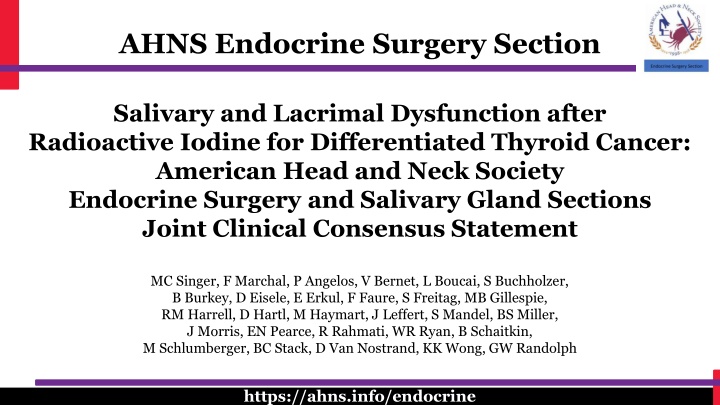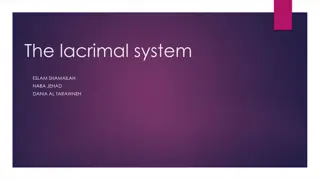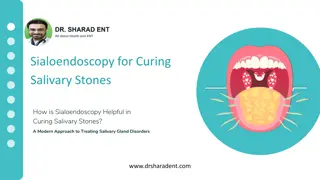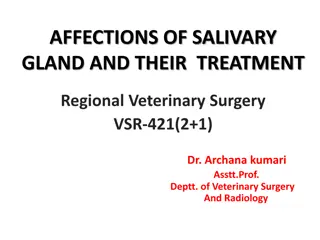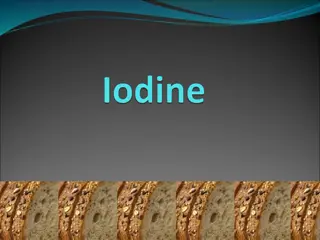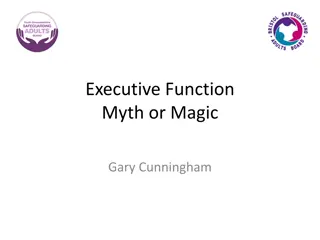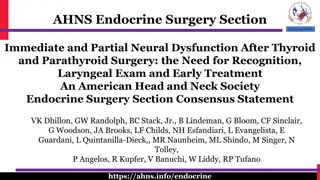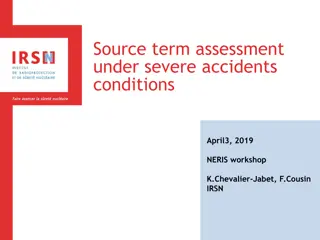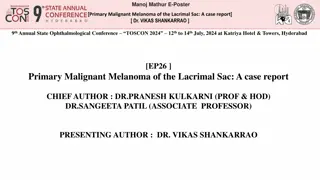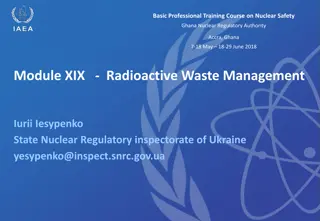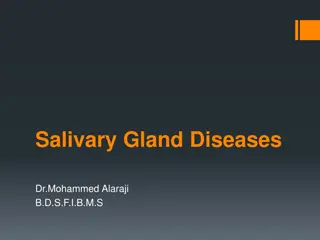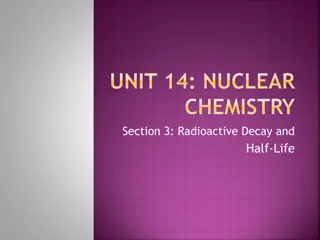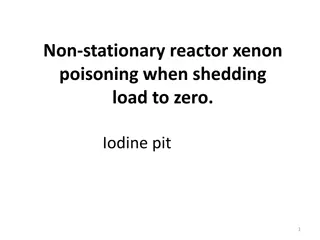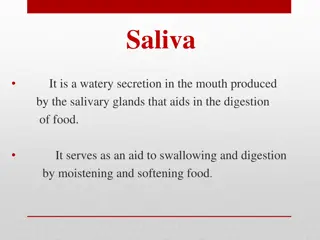Salivary and Lacrimal Dysfunction after Radioactive Iodine Treatment
Radioactive iodine (RAI) is commonly used in treating differentiated thyroid cancer but can lead to salivary and lacrimal dysfunction. This joint clinical consensus statement by the American Head and Neck Society Endocrine Surgery and Salivary Gland Sections highlights the importance of understanding and mitigating these complications. Incidence rates, risk factors, and prevention strategies are discussed to increase awareness and improve patient outcomes.
Download Presentation

Please find below an Image/Link to download the presentation.
The content on the website is provided AS IS for your information and personal use only. It may not be sold, licensed, or shared on other websites without obtaining consent from the author.If you encounter any issues during the download, it is possible that the publisher has removed the file from their server.
You are allowed to download the files provided on this website for personal or commercial use, subject to the condition that they are used lawfully. All files are the property of their respective owners.
The content on the website is provided AS IS for your information and personal use only. It may not be sold, licensed, or shared on other websites without obtaining consent from the author.
E N D
Presentation Transcript
AHNS Endocrine Surgery Section Salivary and Lacrimal Dysfunction after Radioactive Iodine for Differentiated Thyroid Cancer: American Head and Neck Society Endocrine Surgery and Salivary Gland Sections Joint Clinical Consensus Statement MC Singer, F Marchal, P Angelos, V Bernet, L Boucai, S Buchholzer, B Burkey, D Eisele, E Erkul, F Faure, S Freitag, MB Gillespie, RM Harrell, D Hartl, M Haymart, J Leffert, S Mandel, BS Miller, J Morris, EN Pearce, R Rahmati, WR Ryan, B Schaitkin, M Schlumberger, BC Stack, D Van Nostrand, KK Wong, GW Randolph https://ahns.info/endocrine
Background Radioactive iodine (RAI) widely utilized in the management of differentiated thyroid cancer Efforts to move towards more selective usage Critical to consider the potential side effects and risks of RAI including salivary and lacrimal dysfunction Need for greater awareness of these complications and their optimal prevention and treatment AHNS Endocrine Surgery Section - https://ahns.info/endocrine
Methods Multidisciplinary writing group convened by the AHNS Endocrine Surgery and Salivary Gland Sections Included experts from Endocrinology, Nuclear Medicine, Ophthalmology, Endocrine Surgery, Otolaryngology Literature search of RAI complications Recommendations based on literature and expert opinion Endorsed by AHNS QOC and council AHNS Endocrine Surgery Section - https://ahns.info/endocrine
Incidence Incidence of acute sialadenitis ranges from 10-41% Parotid glands in 59 81%; both glands are typically affected Submandibular glands in 16 46% Xerostomia appears 3-12 months after RAI treatment Incidence between 15-54%, Dysgeusia from 13-27% - can be permanent Ocular symptoms, including dryness, pruritus, epiphora, incidence between 2.5-25% Prevalence decreases with time AHNS Endocrine Surgery Section - https://ahns.info/endocrine
Incidence Risk of developing a secondary primary malignancy Divergent results from cancer epidemiologic investigations Given concentration of RAI in salivary gland tissue, these glands are potentially particularly at risk Appears to be correlation between RAI dosing and younger age and risk of secondary primary malignancy Marti JL, et al. Increased risk of second primary malignancy in pediatric and young adult patients treated with radioactive iodine for differentiated thyroid cancer. Thyroid 2015; 25:1159 1172. Clement SC, et al. Intermediate and long term adverse effects of radioiodine therapy for differentiated thyroid carcinoma a systematic review. Cancer Treat Rev 2015; 41:925-934. AHNS Endocrine Surgery Section - https://ahns.info/endocrine
Recommendation 1 Given the potential for salivary and lacrimal side effects as well as secondary primary malignancy, patients in whom RAI therapy is being considered should receive pretreatment education regarding the prevalence and nature of these complications Xerostomia, sialadenitis, dry eyes, epiphora, nasal symptoms and, in rare instances, secondary primary malignancy should be discussed Strong recommendation, moderate quality evidence AHNS Endocrine Surgery Section - https://ahns.info/endocrine
Recommendation 2 Physicians should be aware that secondary primary malignancies can be associated, rarely, with the use of RAI and relates to RAI activity and patient age Given this small but possible risk of a secondary malignancy, including of the salivary glands, kidneys and bone marrow, judicious, evidence based use of RAI is warranted In addition, these risks should be considered when determining optimal follow up Weak recommendation, low quality evidence AHNS Endocrine Surgery Section - https://ahns.info/endocrine
Risk Factors AHNS Endocrine Surgery Section - https://ahns.info/endocrine
Recommendation 3a Given the association between administered activity of RAI, particularly >100 mCi, and frequency/severity of side effects, minimum effective, individualized RAI activity should be utilized Thyroid remnant ablation with 30 mCi of RAI has significantly less risk of inducing complications In patients with thyroid cancer, whose tumors are considered iodine-refractory, unless efforts at redifferentiation are attempted, RAI use should be avoided Strong recommendation, moderate quality evidence AHNS Endocrine Surgery Section - https://ahns.info/endocrine
Recommendation 3b The use of recombinant TSH rather than thyroid hormone withdrawal to prepare for RAI therapy appears to reduce both the risk of salivary and lacrimal gland complications This should be considered when determining the optimal protocol for patient RAI preparation Weak recommendation, low quality evidence AHNS Endocrine Surgery Section - https://ahns.info/endocrine
Recommendation 3c Other factors such as age, interval between RAI treatments, factors relating to salivary gland uptake, preexisting salivary gland disease, and xerostomic medication impact the risk of RAI related complications These should be considered when determining the risk-benefit calculation of RAI treatment for individual patients Strong recommendation, low quality evidence AHNS Endocrine Surgery Section - https://ahns.info/endocrine
Prevention In addition to aggressive hydration, range of interventions often recommended - medications, supplements, sialagogues, and massage Sialagogues appear to have a protective effect Significant debate about when to initiate and frequency Van Nostrand, et al. Radiopharmacokinetics of radioiodine in the parotid glands after the administration of lemon juice. Thyroid 2010; 20:1113 1119. Nakada K, et al. Does lemon candy decrease salivary gland damage after radioiodine therapy for thyroid cancer? J Nucl Med 2005; 46:261-266. AHNS Endocrine Surgery Section - https://ahns.info/endocrine
Recommendation 4a The use of lemon candies/juice and massage as RAI protectants should be considered The exact optimal time to start, frequency, duration, and particular sialagogue and method of massage to use remains unclear Weak recommendation, moderate quality evidence AHNS Endocrine Surgery Section - https://ahns.info/endocrine
Recommendation 4b There is insufficient data to recommend the use of other interventions, including the use of amifostine, vitamin E, selenium, or vitamin C as RAI protectants Weak recommendation, low quality evidence AHNS Endocrine Surgery Section - https://ahns.info/endocrine
Treatment For xerostomia management consists of conservative interventions with adequate hydration, tobacco avoidance and appropriate oral hygiene Treatment of acute sialadenitis consists of nonsteroidal anti-inflammatory medications or oral corticosteroid If there is persistent painful swelling, erythema or pus seen at the papilla, a broad-spectrum antibiotic should be prescribed Sialagogues are contraindicated in the acute phase as they can worsen the symptoms AHNS Endocrine Surgery Section - https://ahns.info/endocrine
Treatment Chronic sialadenitis typified by repeated episodes of salivary gland swelling and pain Salivary stimulants for hypofunctional tissue Sialendoscopy offers a minimally invasive approach to diagnose and manage chronic sialadenitis Can manage ductal strictures which result secondary to RAI exposure AHNS Endocrine Surgery Section - https://ahns.info/endocrine
Recommendation 5 In patients experiencing symptoms after RAI exposure timely referral, to an otolaryngologist for salivary gland and an ophthalmologist for nasolacrimal gland dysfunction, is recommended Strong recommendation, low quality evidence AHNS Endocrine Surgery Section - https://ahns.info/endocrine
Recommendation 6 Sialendoscopy should be considered in patients with RAI induced salivary gland sialadenitis that has not responded to conservative or medical management or that is recurrent or chronic in nature Strong recommendation, low quality evidence AHNS Endocrine Surgery Section - https://ahns.info/endocrine
Salivary and Lacrimal Dysfunction after Radioactive Iodine for Differentiated Thyroid Cancer: American Head and Neck Society Endocrine Surgery and Salivary Gland Sections Joint Clinical Consensus Statement MC Singer, F Marchal, P Angelos, V Bernet, L Boucai, S Buchholzer, B Burkey, D Eisele, E Erkul, F Faure, S Freitag, MB Gillespie, RM Harrell, D Hartl, M Haymart, J Leffert, S Mandel, BS Miller, J Morris, EN Pearce, R Rahmati, WR Ryan, B Schaitkin, M Schlumberger, BC Stack, D Van Nostrand, KK Wong, GW Randolph AHNS Endocrine Surgery Section - https://ahns.info/endocrine
